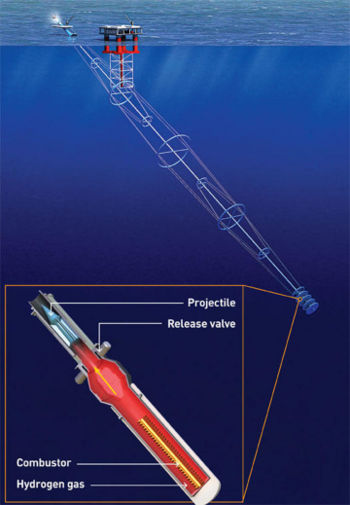Difference between revisions of "Talk:Colonising Space/Access to space"
From AdCiv
| Line 11: | Line 11: | ||
*'''Space guns''' like {{wp|Project_HARP|HARP}}. | *'''Space guns''' like {{wp|Project_HARP|HARP}}. | ||
*'''Linear motor assisted launch''' from high altitude terrain | *'''Linear motor assisted launch''' from high altitude terrain | ||
| + | |||
| + | [[Image:Spacecannon.jpeg|The most promising non-rocket launch method is the 'space gun'. Anything propelled upwards at a speed over 11.2 kilometers per second will escape Earth's gravitational pull and get into space. One of the most straightforward ways to reach this fantastic speed is by firing things out of an enormous hydrogen-powered gun. This would provide a very cheap and practical way of putting materials in space, but the large ''g'' forces involved would make it unsuitable for humans. A space gun holds all the promise of a space elevator or launch loop (i.e. cheap, rough-and-ready access to space) but requires none of the unlikely engineering of either of those two proposals. Quicklaunch Inc. have designed this 1100m-long, hydrogen-powered floating gun that can launch 1000lb payloads into space every few hours for $250/lb. See [http://www.youtube.com/watch?v=1IXYsDdPvbo this Google talk] for more detail.|thumb|center|350px]] | ||
Revision as of 14:57, 15 April 2012
Notes removed, but have valuable info for a proper write-up of the topic of access to space
...we need an efficient, reliable way of getting large amounts of material beyond the Earth's gravitational pull. While incremental improvements in rocket technology may suffice, several very different ways of getting off the planet have been proposed.
- Multi-stage rocket
- Aircraft piggy-back
- Scramjet
 / rocket hybrid, such as the single stage to orbit
/ rocket hybrid, such as the single stage to orbit  (SSTO) Skylon
(SSTO) Skylon  launch vehicle
launch vehicle
- Space elevator
 . Picture a satellite tethered to the Earth — a large weight in geosynchronous orbit is attached by a strong, long, light cable to an anchor-point on the planet's surface. Robots could climb this cable, carrying payloads into space. This is expected to reduce the cost of transporting a pound of material into space to $100 [1], which would completely open up space to all kinds of new ventures. However, there are still many challenges to be overcome before a space elevator is viable: the robots that ascend the cable need a reliable power source, there are dangers of the cable being snapped by lightning strikes, asteroids or orbiting debris and there is doubt as to whether carbon nanotube cables can be made strong enough to withstand the tension generated by such an enormous structure.
. Picture a satellite tethered to the Earth — a large weight in geosynchronous orbit is attached by a strong, long, light cable to an anchor-point on the planet's surface. Robots could climb this cable, carrying payloads into space. This is expected to reduce the cost of transporting a pound of material into space to $100 [1], which would completely open up space to all kinds of new ventures. However, there are still many challenges to be overcome before a space elevator is viable: the robots that ascend the cable need a reliable power source, there are dangers of the cable being snapped by lightning strikes, asteroids or orbiting debris and there is doubt as to whether carbon nanotube cables can be made strong enough to withstand the tension generated by such an enormous structure. - A launch loop
 (illustrated here) is perhaps more feasible than a space elevator as it requires no new materials. It is essentially a conveyor belt to space. It consists of a loop of iron cable anchored on the surface of the Earth at one end, and at a height of 125km above the Earth at the other end. The loop passes through electromagnetic bearings at each end. These bearings spin the cable at high speeds, which creates a centrifugal force that lifts the cable up into an enormous loop, the top half of which is in space. Payloads can use magnets to attach themselves to the cable and ride it into space.
(illustrated here) is perhaps more feasible than a space elevator as it requires no new materials. It is essentially a conveyor belt to space. It consists of a loop of iron cable anchored on the surface of the Earth at one end, and at a height of 125km above the Earth at the other end. The loop passes through electromagnetic bearings at each end. These bearings spin the cable at high speeds, which creates a centrifugal force that lifts the cable up into an enormous loop, the top half of which is in space. Payloads can use magnets to attach themselves to the cable and ride it into space. - Space guns like HARP
 .
. - Linear motor assisted launch from high altitude terrain

The most promising non-rocket launch method is the 'space gun'. Anything propelled upwards at a speed over 11.2 kilometers per second will escape Earth's gravitational pull and get into space. One of the most straightforward ways to reach this fantastic speed is by firing things out of an enormous hydrogen-powered gun. This would provide a very cheap and practical way of putting materials in space, but the large g forces involved would make it unsuitable for humans. A space gun holds all the promise of a space elevator or launch loop (i.e. cheap, rough-and-ready access to space) but requires none of the unlikely engineering of either of those two proposals. Quicklaunch Inc. have designed this 1100m-long, hydrogen-powered floating gun that can launch 1000lb payloads into space every few hours for $250/lb. See this Google talk for more detail.